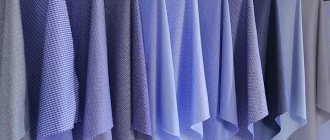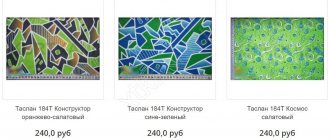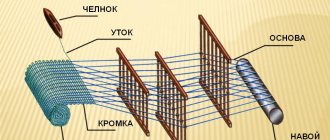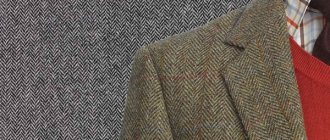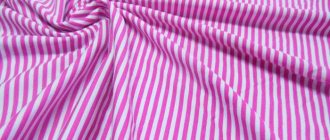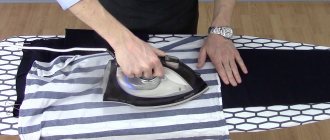Fuqra fabric is a material with a voluminous texture that resembles an embossed pattern.
It was originally made from 100% polyester. Today, along with synthetic threads, fibers from cotton, silk and wool are used. The structure of fukra consists of two layers, thanks to which it is possible to achieve a three-dimensional effect. One side is matte, rough, the other has a glossy sheen, both are used as the front side.
Features and Properties
To understand what kind of fuqra fabric this is, let’s look at its characteristics. The advantage of the material lies in its appearance. The relief pattern, similar to a printed one, looks original, opening up space for designer imagination. Judging by the reviews, the material does not wrinkle and has increased strength and wear resistance.
Synthetic fukra withstands intensive use and numerous washes well and does not shrink.
Regarding the cost, everything depends on the composition. Synthetic fukra is affordable. Products made from natural fabrics, as a rule, are more expensive, one of these is silk fukra.
The material has disadvantages when it is composed of 100% polyester. We are talking about low hygroscopicity and accumulation of static electricity. In addition, the dense structure practically does not allow air to pass through.
Description, advantages and disadvantages
The appearance of the material is very impressive and unusual. The structure of the matter is two-layer and two-sided. The connection fibers between the layers are arranged in a certain pattern, which allows the formation of original three-dimensional patterns and designs. One side is shiny, glossy, the reverse is matte, with a crepe roughness, but both sides can protrude.
The material, in the classic version, consists entirely of polyester and is therefore very easy to care for. It does not lose its shape, does not shrink, does not wrinkle, is elastic and durable. An additional plus is that the fabric is affordable.
The obvious advantages of the canvas largely cover its shortcomings, which still exist. The main ones are the ability to accumulate static electricity, poor breathability and low hygroscopicity. Therefore, wearing clothes made from fuqra in the hot summer is almost impossible.
The nature of the fabric changes depending on the composition of the fibers. To increase hygroscopicity and breathability, cotton, viscose or other “breathable” components are introduced. However, they increase creasing and reduce water-repellency.
Fukra knitwear is elastic, stretches well, is resilient, and at the same time bright and immediately attracts attention.
Clothing made from fuqra is ideal for average temperatures, for cool weather with little wind: the material will warm and protect, while the skin will not sweat. However, it is highly recommended to place such a product on a thin or warm (depending on the model and weather) natural lining.
Does it stretch or not?
Synthetic fukra is usually elastic, this is facilitated by the added spandex threads. If we talk about natural fibers, then a lot depends on the composition of the fabric. Fukra knitwear stretches well, it is pleasant and soft to the touch. High ductility is ensured by the addition of elastane fibers. Knitted fukra is used when sewing women's suits and dresses that fit the figure.
Taffeta and satin fabrics have practically no stretch. No elastane thread is used in their production. The result is a dense and coarse fabric that drapes well and is suitable for the production of curtains and bedspreads. In addition, loose-fitting suits are made from satin.
Fukra: description and reviews about the fabric - stretches or not
Fukra is a material that differs from others in its wrinkled texture. She looks very beautiful and unusual. To obtain the material, fibers from wool, silk, cotton, and synthetics can be used. For real fuqra, the composition remains characteristic, which consists of 100% polyester.
Its structure has two layers. They are interconnected in such a way that it is possible to create various printed patterns and designs. The material in question has a wide range of applications. In addition to sewing women's clothing, it can be used in decorating various decorative elements.
Description and characteristics
If we consider the material, which contains 100% polyester, then it is easy to use. Does not lose its shape, resists shrinkage, does not wrinkle, is durable, stretchy, and has an affordable price.
In addition to the obvious advantages, it is worth highlighting the existing disadvantages of the canvas. Since the material is synthetic, it is in many ways inferior to natural materials, such as wool and cotton. The disadvantages of fuqra remain the presence of static electricity, as well as the inability to “breathe”. Thus, it is simply impossible to wear items made from fuqra in the summer. But the properties of the material can be variable, since everything depends on the impurities contained in the fabric. But whether viscose is a natural fabric or synthetic, and where it is used, is indicated here.
In the photo - fukra fabric:
As noted above, synthetics are capable of generating static electricity, they are non-hygroscopic and practically do not allow air to pass through. Polyester knitwear can only be used at moderate temperatures. And when sewing clothes from fuqra, you should take care of the breathable lining.
It may also be useful for you to learn about what fabric to choose for bed linen.
In order for a product to retain its appearance for as long as possible, you need to know how to properly care for it. But in this case, care tips are largely determined by the composition of the product. General recommendations include a ban on ironing, as this can negatively affect the texture. If you still can’t do without ironing, then you should use steaming at minimum power.
But as for washing, polyester fukra can be washed at home in a machine. But for silk fabrics, washing is contraindicated; here you will have to go to the dry cleaner. The specifics of caring for fukra depend on its composition, so you need to carefully read the recommendations that are indicated on the product label.
But what is the composition of Ranfors fabric, and where it is used most often, is indicated here.
Composition and types
When creating fukra, various raw materials can be used, both synthetic and natural. Most often this is:
- cotton;
- wool;
- linen;
- silk;
- polyester.
But you can read in this article how and where you can use Blackout curtain fabric.
Still, fuqra made from polyester is in great demand. The peculiarity of the material is that it has two front sides. Moreover, one has a matte surface, a crepe structure, and the second has a glossy surface with a smooth texture.
Fuqra fabrics can be of several types, including:
- satin fukra;
- jacquard fukra;
- taffeta-fuqra;
- Turkish;
- lightweight;
- costume;
- knitted
What modal fabric looks like, and how good such fabric looks, and where it is most often used, is indicated in the article at the link.
Application
The main purpose of the material is determined by its texture, color and composition. As a rule, fukra is a knitwear that is used for sewing women's clothing. You can get the following clothing options from it:
- various suits: evening, sports;
- dresses, skirts; To make a skirt, you can try using Tencel fabric
Since fukra has an original texture, it looks elegant even on the simplest cover. Thus, it is possible to obtain voluminous silhouettes and use creative combinations of cut elements with different surfaces. But what are the properties of spandex fabric, and how to properly use it in making clothes, you can find out here.
In addition to sewing clothes, fukra has proven itself in the manufacture of the following parts:
- drapery;
- decorative textiles for various purposes.
But where you can use calico fabric, and what products you can make. This information will help you understand.
Bulky knitwear is used in the manufacture of furniture upholstery, bags, and various household items. The products are distinguished by their long service life, practicality and decorative appearance.
But thin, voluminous polyester has found its application as an elegant lining fabric. (percale fabric can also be used) In this case, the matte side is applied to the wrong side of the product. Thus, the lining will fit tightly to the main material and, at the same time, slide over the figure. If we are talking about natural silk and wool fukra, then this is an elite material. Designers from high fashion houses work with her. It is used to make exclusive stoles, scarves, ties and other stylish clothing.
Types by composition
Fukra can be made from the following fibers:
- synthetic;
- natural;
- mixed (a combination of natural and synthetic).
As mentioned in the description above, fuqra, consisting of polyester, is considered traditional.
This is a durable, wear-resistant and inexpensive material that has a beautiful appearance and does not lose its shape during long-term use. Along with polyester, acetate and viscose threads are used. Among natural fabrics, popular options for making fukra fabric are:
- silk;
- cotton;
- linen;
- wool;
- viscose.
To obtain high technical characteristics, some manufacturers make fukra by mixing natural and synthetic fibers. Blended fabrics get the benefits of both types; the materials are highly breathable and hold their shape after numerous washes. To obtain increased strength, metal threads can be added to the fabric; they also give the lurex effect.
Main characteristics
The general characteristics of all materials with this name are only the features of the texture of the canvas, while the remaining properties completely depend on the composition.
Since polyester fukra is the most popular, we will talk about it in this case. So, the main advantages:
- wear resistance. The fabric is quite durable and has good tensile strength;
- ease of use. Low creasing, the product does not wrinkle, is easy to wash, dries quickly;
- resistance to deformation. Does not lose shape, does not shrink or stretch.
- ease of care. Fukru with a polyester composition can be washed at home;
- affordable price.
Flaws:
- airtightness. Poor air permeability and does not allow the skin to breathe;
- low hygroscopicity. The products do not absorb moisture and do not release it outside, which is unhygienic;
- tendency to accumulate static electricity. It becomes electrified and “shoots”.
Application
Due to its attractive appearance, the fabric is used to make:
- Dense and wear-resistant synthetic material is used to make upholstery for upholstered furniture. Satin covers for sofa cushions are popular.
- Bed linen, curtains and curtains are made from fuqra.
- The fine fabric is used to make underwear, pajamas, dresses, blouses and skirts. Women's clothing made from fuqra can be made in both a conservative and youth style.
- Suits and jackets are made from medium-density fabric.
- Material with the addition of wool fibers is used for sewing cardigans and coats. In addition, wool fukra is popular in the production of shawls, mittens, scarves and scarves.
- Thin synthetic fabrics can be used as lining.
Application area
Fukra knitwear is an excellent solution for women's casual dresses. They do not stretch when worn, look attractive and unusual, and emphasize the advantages of the figure.
Fukru is used as costume fabric. It is used to make trousers and jackets for evening outings. The material is suitable for sewing skirts of various models, including everyday ones.
Dresses can be made from fukra fabric; it drapes well and holds its shape. This gives room for imagination. Products with a complex cut look elegant.
Blouses and men's shirts are made from fuqra. Most often these are evening models.
Ties and scarves for men are made from silk fabric. For women - scarves, stoles.
The material is used for sewing outerwear: summer bombers, coats, raincoats. Demi-season clothing models are also made from wool. 100% polyester is suitable for lining.
Care
How to wash and dry fleece items is indicated on the tag or label on the back seam. Like most synthetic products, fukra can be washed in a washing machine at a temperature of no more than 40°, on a synthetic or delicate cycle.
It is prohibited to bleach such items or machine dry them. It is also not recommended to dry fuqra items in direct sunlight or over artificial heat sources. This fabric cannot be ironed. To ensure as few creases as possible on the product, dry it flat. If necessary, run the steam generator at minimum power.
Silk-based fukra cannot be machine washed. It would be better to take such an item to the dry cleaner. Woolen fabric can be washed by hand, but only with the use of special gel products for wool. With this type of washing, it is advisable not to rub the item, but to soak it for half an hour and rinse thoroughly. It is better to dry the fukra in a horizontal position on a terry towel.
Features of care
To ensure a product looks good for a long time, you need to know the rules of care and not neglect them. It is better not to iron textured fabric, otherwise the three-dimensional design may lose its appearance. If ironing is unavoidable, it is recommended to use steaming at a minimum temperature.
If we are talking about washing, then the restrictions are not so strict. Synthetic fukra can be processed well in a home washing machine. But the cleaning of silk material will have to be entrusted to dry cleaning professionals, since washing is strictly contraindicated for it. The principles of caring for fukra depend on the constituent fibers of the fabric, so you should carefully study the recommendations on the clothing labels.
In general, set the mode for delicate fabrics, heat the water no higher than 30˚ C, with a spin speed of no more than 500 rpm. Dry in a vertical position, hanging on hangers - the fabric will dry quickly and straighten out, so no ironing is required.


